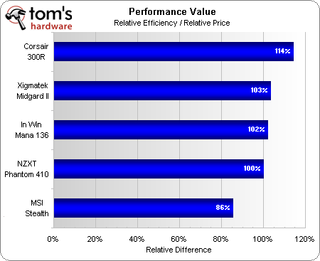Five Gaming Cases Between $80 And $120, Reviewed
Which Chassis Delivers On Value? How About Quality?
NZXT’s Phantom 410 provides the lowest temperatures, lowest noise, and best acoustic efficiency of the five cases in today’s test. If this were simply a matter of performance, we could conclude our project without further description. However, Corsair’s performance is pretty impressive as well, and its price is also rather good.

Thus, anyone looking for the best bang-for-the-buck case will probably jump on Corsair’s 300R. Indeed, we were even able to find the case for $10 less than the $80 floor set for this story's budget range, and using that lower number would have given the case an even higher value score. But we're not really convinced that “mainstream” is the place for Corsair’s 300R. It's flimsy materials and limited number of ports are more closely-matched by several $60 models.
Xigmatek’s Midgard II takes second place in a comparison of performance to price, being the cheapest case in today’s article that really deserves to be called a mainstream gaming-oriented product. That judgement is based solely on material quality and features.
In Win’s Mana 136 looks the part of a mid-range enthusiast chassis, just like Xigmatek's, and it even has the heavy face panel and paint to match. Unfortunately, underneath those accoutrements lies the structure of a $30 budget box.
NZXT gets things right on quality, noise, and cooling, but falls to the back of the pack when it comes to value.
MSI's Stealth edges out the three lightweights on structural quality, but added features such as its SRF rubberized finish, USB charging port and VGA stabilizer brackets can't make us forget that it consistently lags behind when it comes to cooling, noise, and acoustic efficiency.
Value was supposed to be a primary consideration in today’s comparison. However, the highest value score goes to an enclosure built more like cases in a more entry-level class. We're looking for sturdier materials in the $80 to $120 segment. Quality was always supposed to be another important criteria in our round-up. And that’s where a single product really stood out.
Stay on the Cutting Edge
Join the experts who read Tom's Hardware for the inside track on enthusiast PC tech news — and have for over 25 years. We'll send breaking news and in-depth reviews of CPUs, GPUs, AI, maker hardware and more straight to your inbox.

Unable to make a clear case for a value award (Ed.: I see what you did there), we're choosing to recognize the case that won everything except the price battle. The only product in this comparison to meet all of our performance and quality demands, NZXT’s Phantom 410 gets our stamp of approval.
Current page: Which Chassis Delivers On Value? How About Quality?
Prev Page Temperature, Noise, And Acoustic Efficiency-
Ramlethal why is it between 80 to 120 if the most expensive ones are 410 and stealth priced at 100 ?Reply -
Crashman Reply
Because it was written four years ago?19046365 said:why is it between 80 to 120 if the most expensive ones are 410 and stealth priced at 100 ?
-
Tschrom Honestly, that's probably still true today, if not even cheaper. You can find good quality Full ATX cases for around $80 now, and to spend that much ($410) on a case is just a waste of money. If you really know what you're doing, you don't need to spend anywhere near that much on a case just to house your components. I'm using a Thermaltake Versa H22 SE, which is pretty small (only a mid-ATX case and cheap at only $40) in regards to cases, yet I am able to keep everything quite cool and even made some manual customizations to the case to ensure everything fits well and works well. And I'm using only Air Cooling. Really the case you use comes down to "do the components fit, and is there adequate cooling". Even then, the cooling part can be adjusted to what is necessary with some manual customizations or even just so much as ensuring that your case fans' CFM is adequate for cooling of your currently installed components (or water, but water cooling doesn't work in my current setup so I have no opinion on that).Reply
Most Popular


